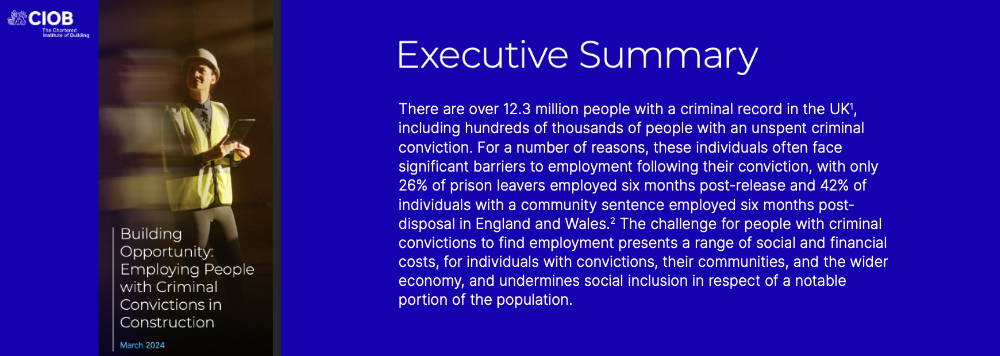Employing People with Criminal Convictions in Construction
This report looks into the barriers and opportunities to recruit people with a criminal conviction into the sector.
Negative stigma and a lack of proper training opportunities are blocking many people with criminal records from earning a second chance at life within the construction industry, a Chartered Institute of Building (CIOB) report has revealed.
The report, Building Opportunity: Employing People with Criminal Convictions in Construction, shows individuals with a criminal record often face significant barriers to gaining employment within the industry including perceived risk to the business by employers and fears about business reputation. However, the report also shows that many construction businesses are taking proactive steps to make recruitment more accessible for people with criminal convictions.
It urges the Government to break down barriers and provide more accessible training opportunities to improve individual’s employability and ease the skills shortage in the construction industry.
Statistics show nearly 70 per cent of people leaving prison* are still without work six months after their release. CIOB says breaking down barriers could lower unemployment amongst people with criminal convictions and increase construction companies' social value impact.
A copy of the full report can be accessed via this link Employing People with Criminal Convictions in Construction report
Please note following a request from the New Futures Network (NFN), this statistic has been changed from nearly 75 per cent to nearly 70 per cent.
This article appears on the CION news and blog site as "Employing People with Criminal Convictions in Construction" dated March 12, 2024 and was written by Niamh Evans
[edit] Related articles on Designing Buildings
- Apprenticeships for prisoners.
- Building back better with apprenticeships.
- CIOB aims to help ex-offenders build a career in construction.
- Construction apprenticeships.
- Ex-offender Community.
- Industry work placement.
- Projects deliver meaningful change at young offenders institution.
- Non-residential institution.
- Residential institution.
- Secure residential institution.
- Tackling the construction skills shortage.
Featured articles and news
Key points for construction at a glance with industry reactions.
Functionality, visibility and sustainability
The simpler approach to specification.
Architects, architecture, buildings, and inspiration in film
The close ties between makers and the movies, with our long list of suggested viewing.
SELECT three-point plan for action issued to MSPs
Call for Scottish regulation, green skills and recognition of electrotechnical industry as part of a manifesto for Scottish Parliamentary elections.
UCEM becomes the University of the Built Environment
Major milestone in its 106-year history, follows recent merger with London School of Architecture (LSE).
Professional practical experience for Architects in training
The long process to transform the nature of education and professional practical experience in the Architecture profession following recent reports.
A people-first approach to retrofit
Moving away from the destructive paradigm of fabric-first.
International Electrician Day, 10 June 2025
Celebrating the role of electrical engineers from André-Marie Amperè, today and for the future.
New guide for clients launched at Houses of Parliament
'There has never been a more important time for clients to step up and ...ask the right questions'
The impact of recycled slate tiles
Innovation across the decades.
EPC changes for existing buildings
Changes and their context as the new RdSAP methodology comes into use from 15 June.
Skills England publishes Sector skills needs assessments
Priority areas relating to the built environment highlighted and described in brief.
BSRIA HVAC Market Watch - May 2025 Edition
Heat Pump Market Outlook: Policy, Performance & Refrigerant Trends for 2025–2028.
Committing to EDI in construction with CIOB
Built Environment professional bodies deepen commitment to EDI with two new signatories: CIAT and CICES.
Government Grenfell progress report at a glance
Line by line recomendation overview, with links to more details.
An engaging and lively review of his professional life.
Sustainable heating for listed buildings
A problem that needs to be approached intelligently.
50th Golden anniversary ECA Edmundson apprentice award
Deadline for entries has been extended to Friday 27 June, so don't miss out!
CIAT at the London Festival of Architecture
Designing for Everyone: Breaking Barriers in Inclusive Architecture.
Mixed reactions to apprenticeship and skills reform 2025
A 'welcome shift' for some and a 'backwards step' for others.




























